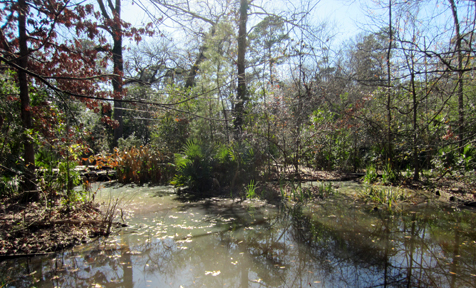
Edith L. Moore Nature Sanctuary, Houston
By Tim Radford
Climate News Network
Climate scientists who calculated the value of urban forests to the world’s great cities have now worked out how town planners can almost double their money. Just plant 20 percent more trees.
More than half the world now lives in cities, and one person in 10 lives in a megacity: one that is home to at least 10 million people.
The trees that shade the parks and gardens and line the urban streets – London planes, limes, magnolias, pines and so on – are known to add to property values and to make living conditions better for millions who must endure the increasing heat extremes of the urban world.
Last year researchers put a value on the contributions of the urban forest: $500 million to the average megacity, they calculated, in pollution absorbed, temperatures lowered and moisture taken up.
More needed
Now Theodore Endreny, professor of environmental resources engineering at the State University of New York, and colleagues from Parthenope University in Naples, Italy, report in the journal Ecological Modelling that there is more to be done.
Tree canopies already cover 20 percent of the area of their 10 sample megacities in five continents. They looked at their models of tree cover, human population, air pollution, energy use, climate and spending power and found room for improvement: the same cities could find room for 20 percent more forest.
“By cultivating the trees within the city, residents and visitors get direct benefits,” Endreny said. “They’re getting an immediate cleansing of the air that’s around them.
“They’re getting that direct cooling from the trees, and even food and other products. There’s potential to increase the coverage of urban forests in our megacities, and that would make them more sustainable, better places to live.”
“While nature provides a bounty of essential goods and services, such as food, flood protection and many more, it also has rich social, cultural, spiritual and religious significance”
Cities are afflicted by the notorious heat island effect, and climate scientists have repeatedly warned that extremes of heat and humidity could rise to potentially lethal levels in many of the world’s great cities.
The latest study is part of a wider shift in approach by urban planners and civic authorities to seek ways to mitigate the climate change driven by ever more profligate consumption of fossil fuels, without actually adding to this consumption by installing ever more air conditioning plant.
And on the same day, a second team of scientists emphasized the same conclusion: work with nature to confront climate change and improve the lives of people in the developing world, put at risk by climate change driven in part by the despoliation of the forests and the degradation of the land.
They argue in the journal Science that a better understanding of the way nature – in the form of forests, wetlands, savannahs and all the creatures that depend on the natural world – underwrites human wellbeing should inform political and economic decisions.
Local knowledge
In many cases, this would involve attending to the wisdom and experience of local communities and indigenous people who depend more directly on nature’s riches.
“Nature’s contributions to people are of critical importance to rich and poor in developed and developing countries alike. Nature underpins every person’s wellbeing and ambitions – from health and happiness to prosperity and security.
“People need to better understand the full value of nature to ensure its protection and sustainable use,” said Sir Robert Watson, chair of the Intergovernmental Platform on Biodiversity and Ecosystem Services.
“This new inclusive framework demonstrates that while nature provides a bounty of essential goods and services, such as food, flood protection and many more, it also has rich social, cultural, spiritual and religious significance – which needs to be valued in policymaking as well.”
+++++
This article was originally published by U.K.-based Climate News Network, which is run by four volunteers. All are veteran journalists who have covered climate change for many years for leading British newspapers and broadcasters and are now freelancing.
